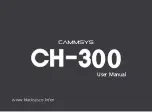
V1.02
Thom Hogan’s Complete Guide to the Nikon D300
Page 155
(RGB)
. Indeed, I’d go one step further and say set
Sharpening
to
0
in your Picture Control if you don’t mind
sharpening after the fact. Why? Because a TIFF image with no
sharpening in it has essentially
no
artifacts in it—you’ll be
doing your post processing sharpening on the best possible set
of data the camera can provide outside of raw files. And you
can do better sharpening during post processing than the
camera can do.
Just make sure you optimize your exposure for the scene,
though. Reducing image data to 8-bits is dangerous if you
need to do exposure correction after the fact, as you just don’t
have many bits to work with in the shadows.
Personally, I’m glad Nikon gave us TIFF back, as it gives us an
image format that can produce very high quality images if
exposed correctly.
NEF Format
NEF format often confuses Nikon DSLR newcomers (Nikon
and others sometimes also refer to this format as RAW). Nikon
advertises it as the highest quality format, one that preserves
the “raw” image photosite data. What Nikon doesn’t tell you
is that you usually need to purchase an additional software
product to really get the most from this format
55
. Nikon
Capture NX 1.3 is what Nikon recommends, but other
alternatives exist (see the appropriate section in the
Introduction to Nikon Software
eBook that accompanied this
eBook). Nikon ViewNX, which was included with all D300
shipments, can also do NEF conversions.
Note that the data saved in a D300 NEF file is pretty much
what comes from the Bayer-pattern sensor in the camera. That
“pretty much” qualification in the last sentence has partly to
do with the way Nikon defines “black” in raw data, and partly
to do with the compression options for raw data.
55
The first 300,000 D3 and D300 owners received a free copy of Nikon Capture NX
1.3, which is Nikon’s raw conversion program.
















































